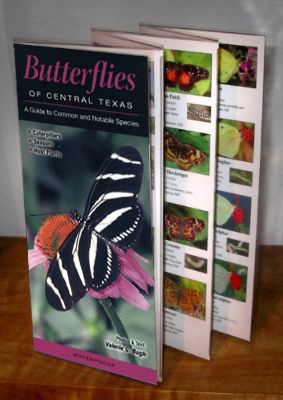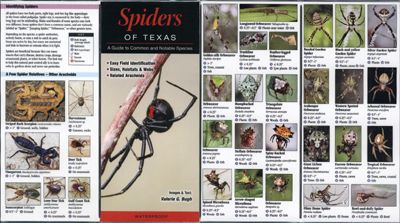
A photographic guide to the insects, spiders, and related arthropods found in Austin, Texas |

Insects |
 | For quick field identification of butterflies specific to central Texas, my guide is the perfect resource. It is laminated, contains photos of and information on 83 species, includes caterpillars, and retails for $7.95. The convenient folding shape fits into a pocket or pack. It is being sold at such venues as Barnes & Noble, Garden Centers, HEB stores, the Lady Bird Johnson Wildflower Center, Austin Bergstrom Airport, and Zilker Botanical Gardens. I have also created a similar guide for the Texas spiders. They are almost as colorful as butterflies, and, in my opinion, far more interesting!
 |
This site is still under construction, but I've put it online because some segments contain useful information. For example, all the introductions to the insect orders are finished. At this time the following categories are either complete or at least have a significant portion done: Hemiptera (true bugs, etc.), Odonata (dragonflies, damselflies), Coccinellidae (ladybugs), Cerambycidae (longhorn beetles), Tettigoniidae (katydids), Lepidoptera (butterflies and noctuids only), Salticidae (jumping spiders). I'm working on the rest! ~ |
I am a collector (fossils, stamps, shells - you get the idea). I've always liked insects but didn't want to bother with the mess and storage problems of having a lot of their little corpses sitting around. The digital camera has made it possible for me to go out and hunt the miniature beasts, bag them with a photo, and we can both happily go our own ways afterward. So these images are my bug collection.
While there are a lot of representative species here, this collection is not complete. With the huge number of arthropods, it is unlikely that I will ever see even the majority of them, let alone get a usable photo out of the encounter. Those that are common are probably included. I have created this site to help others who are trying to sort through the insects and spiders that they find in our little segment of Texas. While the vast majority of the images were taken here in Austin, I have sometimes used pictures taken elsewhere, mainly because they are of better quality or illustrate some salient feature. These are usually mentioned as being from other places.
The subjects in this site are arranged following standard taxonomic organization (class / order / family / genus / species). That's about the only way I can think of that will make the huge amount of information at least marginally accessible. This does then require a certain amount of narrowing down when you have a new bug to identify. Start with the big groups: is it a spider, insect, or something else? Then try to get it down another level: if it is an insect, is it a beetle, butterfly, or some other familiar category? Or is it something you've never seen before? A site like this becomes more useful as your knowledge increases but I've tried to make it easy to get started.
I've used metric measurements in the text descriptions for several reasons. These have become fairly standard in the scientific literature and are used in a good number of popular field guides. Also, I've noticed that people have a hard time judging size when it comes to insects and spiders (long legs and antennae do not help matters). This is probably because they are on such a different scale than most other animals with which we interact. In general, it is more common to overestimate the size of a bug than to fall short. A roach that is described as "2 inches long" is probably barely over an inch. We simply apply different standards to these creatures so alien-looking to us. With a little practice, it becomes easy to use millimeters when dealing with tiny invertebrates. The scale fits them; instead of using fractions of an inch, a small number of millimeters is a more efficient way of conveying information. Just a few of the animals described here exceed one inch in length, while the majority fall into the "less than 1/2 inch" category. Here's a tip for becoming a bit more accurate when judging insect size: measure one of your fingernails and memorize how many millimeters long or wide it is. You will always have this measuring tool handy in the field.
All photos on this site were taken by me and are copyrighted by larvalbug. Because of technical considerations (bandwidth, storage space, dial-up modems, many illustrations vs. text), the photos are closely cropped and reduced in size on these pages; I have tried to balance this restriction by making the images as clear as possible so they will be of some use in identification. If you wish to use images or obtain higher resolution files, contact .
Yes, I do identifications by . Just write to and attach a closely-cropped image of your unknown insect or spider. It helps to add information such as location, size, and host plant. I'll do my best to tell you what I can about it.
This site is part of a sizeable collection of web pages under the name of LARVALBUG. We invite you to visit our other sites:
- larvalbug's home page A family and investment newsletter, with archives.
- larvalbug's garden Garden Bits: Nature photography and short essays.
- larvalbug eye Free nature photos for personal, nonprofit, and educational use.
- larvalbugtoo Artwork by Valerie.
- larVALUEbug Value investing articles by Larry.
- Frisky's Section Photo galleries and humor featuring dogs and other animals.
- Periwinkle's Page The exploits of a wire fox terrier, presented with pictures.
- larvalbugGIF Free clip art with a nature theme.
- larvalbugzoo Wild and zoo animal photo galleries.
- Entomology Class Links and resources for LLI Class.